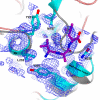Unique MAP Kinase binding sites
- PMID: 18068683
- PMCID: PMC2266891
- DOI: 10.1016/j.bbapap.2007.09.016
Unique MAP Kinase binding sites
Abstract
Map kinases are drug targets for autoimmune disease, cancer, and apoptosis-related diseases. Drug discovery efforts have developed MAP kinase inhibitors directed toward the ATP binding site and neighboring "DFG-out" site, both of which are targets for inhibitors of other protein kinases. On the other hand, MAP kinases have unique substrate and small molecule binding sites that could serve as inhibition sites. The substrate and processing enzyme D-motif binding site is present in all MAP kinases, and has many features of a good small molecule binding site. Further, the MAP kinase p38alpha has a binding site near its C-terminus discovered in crystallographic studies. Finally, the MAP kinases ERK2 and p38alpha have a second substrate binding site, the FXFP binding site that is exposed in active ERK2 and the D-motif peptide induced conformation of MAP kinases. Crystallographic evidence of these latter two binding sites is presented.
Figures





References
-
- Chen Z, Gibson TB, Robinson F, Silvestro L, Pearson G, Xu B, Wright A, Vanderbilt C, Cobb MH. MAP kinases. Chem. Rev. 2001;101:2449–2476. - PubMed
-
- Johnson GL, Lapadat R. Mitogen-activated protein kinase pathways mediated by ERK, JNK, and p38 protein kinases. Science. 2002;298:1911–1912. - PubMed
-
- Deng Q, Liao R, Wu BL, Sun P. High intensity ras signaling induces premature senescence by activating p38 pathway in primary human fibroblasts. J. Biol. Chem. 2004;279:1050–1059. - PubMed
-
- Ferrell JE, Jr., Bhatt RR. Mechanistic studies of the dual phosphorylation of mitogen-activated protein kinase. J. Biol. Chem. 1997;272:19008–19016. - PubMed
-
- Pearson G, Robinson F, Beers Gibson T, Xu BE, Karandikar M, Berman K, Cobb MH. Mitogen-activated protein (MAP) kinase pathways: regulation and physiological functions. Endocr. Rev. 2001;22:153–183. - PubMed
Publication types
MeSH terms
Substances
Grants and funding
LinkOut - more resources
Full Text Sources
Other Literature Sources
Miscellaneous

